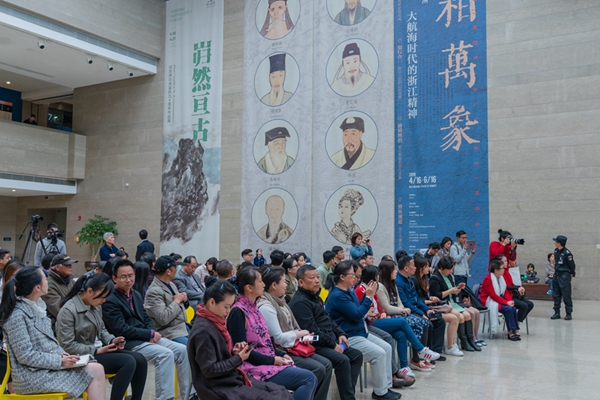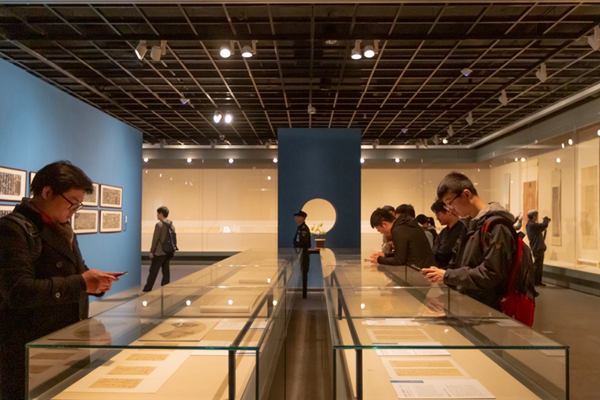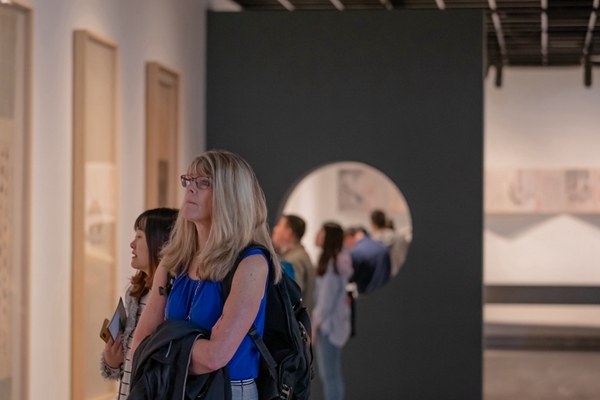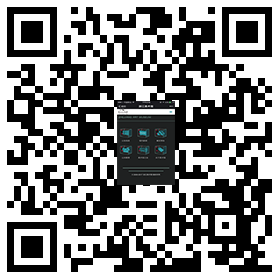“The Minds•and All Beings — Zhejiang Spirit in the Age of Discovery” Is Opened
pubdate: 2019/4/16 author: zjam source: zjam click:
On the morning of April 16, 2019, an exhibition named “The Minds•and All Beings — Zhejiang Spirit in the Age of Discovery” organized by ZJAM and He Chuangshi Calligraphy Art, Culture and Education Foundation (Taiwan, China), and co-organized by China Academy of Art (CAA), Nanjing Museum, Zhejiang Provincial Museum, Zhejiang Library and Tianyige Museum was opened at ZJAM. As the first commemorative exhibition for the 10th anniversary of ZJAM, this exhibition mainly featured more than 120 pieces (series) of calligraphy works, paintings, as well as historical materials and woodcut ancient books created by elites from and settling in Zhejiang during the Ming Dynasty.
.jpg)
The opening ceremony was held in the form of academic salon. In particular, important guests, including Professor Fan Shuzhi from Fudan University, Professor Bai Qianshen from Zhejiang University, Professor Ren Daobin from the CAA, Professor Wu Yanhong from Zhejiang University, and Mr. He Guoqing, chairman of tHe Chuangshi Calligraphy Art, Culture and Education Foundation, were invited to interpret the exhibition from academic and humanity perspectives concerning history, cultural history, art research, and exhibits for the audience and media. The opening ceremony was hosted by Ying Jinfei, curator of ZJAM
On the occasion of the 10th anniversary this year, ZJAM will launch a series of classic feature projects spanning from ancient to modern and from eastern to western themes, for the purpose of “constructing cultural narratives from an artistic perspective and interpreting the humanistic connotations of material subjects”. The planned exhibitions include “The Minds and All Beings”, “Paper Polish Art”, “Exhibition of Works by Wu Guanzhong” and “Hangzhou Triennial of Fiber Art”, and they are designed to carry on the Chinese civilization and the spirit of Zhejiang. As the first special exhibition for the 10th anniversary of the museum, “The Minds and All Beings — Zhejiang Spirit in the Age of Discovery” has profound meaning and great significance.

At the opening ceremony, Curator Ying Jinfei first introduced the curatorial concept, exhibition structure and academic cooperation about this exhibition. He said that ZJAM is committed to the overall cultural construction of the country in the new era. In recent years, it has been assuming the responsibility for social aesthetic education aimed to “distribute positive energy”. With preparations started in 2017, “The Minds and All Beings” was the first example of deep “academic + art” cooperation between ZJAM and universities. Professor Fan Shuzhi from Fudan University, Professor Gong Pengcheng and Professor Zhang Fan from Peking University, Professors Lou Hansong, Professor Wu Yanhong and Professor Xu Yongming from Zhejiang University, and Professor Ren Daobin from the CAA offered professional guidance and were sincerely appreciated. The academic joint forces of Peking University, Zhejiang University and Fudan University made the cultural heritage of this exhibition even more profound. In addition, Zhou Ren and Huang Peng, who are researchers at the Cultural Relics Identification Center of Zhejiang Province, also extended their support and assistance. The exhibition also received generous assistance from Nanjing Museum, the CAA, Zhejiang Provincial Museum, Zhejiang Library, Tianyige Museum, and China Port Museum. The concerted effort was made for the common goal of presenting a cultural feast to the audience.
Professor Fan Shuzhi spoke highly of the theme of this exhibition. He said in his speech that this exhibition provided a profound historical perspective for us to understand the current “Zhejiang spirit” and moved us beyond what we are now confined to. From the late 15th century to the early 16th century, the world entered the age of discovery. China not only embraced this era, Zhejiang at that time was right at the forefront of the world trend. The “Zhejiang spirit” that embraced the world and raced to the top has been a deep seated trait. Thus, this exhibition was of not only historical significance but also realistic implication.
“Zhejiang spirit”, originating from the age of discovery, runs from the past to the present and is the highlight of this exhibition. Firstly, Zheng He’s voyage to the West was a prelude to “the era of the discovery" in the history of the world, followed by the discovery of the Americas and the first global voyage of mankind. The Chinese was the first pioneer in this history. Secondly, the global trade opened up by the age of discovery was summarized by Western scholars as “silk-silver exchange”: Chinese silk and silk products flowed out, most importantly Huzhou silk from Zhejiang Province, while foreign silver flowed in. Thirdly, foreign missionaries coming after the age of discovery triggered the “eastward spread of Western sciences”, and “Great Universal Geographic Map” (《坤舆万国全图》) was the witness of the cooperation between Li Zhizao, a native of Hangzhou, Zhejiang, and foreign missionary Matteo Ricci after he came to China. Li Zhizao, Yang Tingyun and Xu Guangqi were all advanced Chinese intellectuals with global vision in the Ming Dynasty. They also emerged in a specific historical trend as products of the discovery age. Therefore, the discovery age was closely associated with China, especially with Zhejiang. The exhibition plan was thoughtful, literary and passionate. The message from the exhibition was that the far-reaching “Zhejiang spirit” could be traced back to hundreds of years ago.

Professor Bai Qianshen also talked enthusiastically about the theme of the exhibition, “the age of discovery”. He explained from the perspective of humanities and art, “I was born in a seaman family, so I am particularly interested in the topic of navigation. Speaking of sea and art, it is actually all about the relationship between convenient overseas transportation and economic and trade exchanges and art communication in the age of discovery. Written exchanges between China and foreign countries actually started very early. To track farther back, many paintings originating from the Southern Song Dynasty are now found in Japan because they were brought there from Ningbo, Zhejiang. If we read Matteo Ricci’s China notes, we would find many interesting observations of Italian missionaries about Chinese art. For example, they found that Chinese people liked calligraphy very much and that fans were popular gifts among the Chinese. These observations were long lost in our records as they were taken for granted instead of being treated seriously.”
Therefore, according to Professor Bai, “We should not only focus on navigation in the age of discovery, but also plenty of literature about art history over the course of exchanges between China and foreign countries. ‘Zhejiang Spirit in the Age of Discovery’ is a very good topic. In China, Zhejiang, Guangdong and Fujian are the most important coastal provinces for navigation. Zhejiang, in particular, is a pioneer that brings not only economic but also social benefits through foreign exchange. I can’t agree on the intention of the exhibition more. It is of particular meaning for a descendant of a seaman family.”

Professor Wu Yanhong summarized the academic work of this exhibition. She said, “I am very happy to be involved in the academic work of this exhibition. Three of my doctoral students, one of my master students and I formed an academic editorial team. It took us more than a year to deeply study and sort out the authors and works related to the exhibition. We finally presented an academic achievement of more than 60,000 Chinese characters in the form of exhibition notes and portfolios to the audience.”
“On the other hand, many ordinary people simply have fragmented and negative understanding of the history of the Ming Dynasty. We hope that our research would enrich the presentation of this exhibition and bring three benefits to the audience. Firstly, we hope to offer them a chance to appreciate the artistic beauty of the calligraphy works and paintings. Secondly, we hope they could learn about the authors behind these works because the works convey their voices, and they could also learn about their times and pay attention to the outstanding female artists emerging in the times. Thirdly, we hope this exhibition could be a window for the audience to track the past days of Zhejiang, especially the South China, which was both economically and culturally advanced at that time.
Professor Ren Daobin felt sorry about the Notre Dame de Paris and appreciated the preciousness of great art. Professor Ren recalled that he was asked by a collector from Hong Kong to hold an exhibition of letters written by wise men from Zhejiang during the Ming Dynasty but failed to do it for various reasons 15 years ago. He has been sorry ever since. Now he was delighted to find that the exhibition of “Zhejiang Spirit in the Age of Discovery” hosted by ZJAM presented many precious works created and introduced by Zhejiang people in that age. He praised the innovative and revolutionary spirit of Zhejiang people since ancient times. “The unity of knowledge and action” put forward by Wang Yangming and “Great Universal Geographic Map” (《坤舆万国全图》) jointly inscribed by Li Zhizao, a native of Hangzhou, and Matteo Ricci confirmed the long-lasting position of Zhejiang as an open, inclusive and absorptive hub in the whole world. Zhejiang spirit is a synonym for bold thinking, bold actions, pragmatism, and hard work.
Mr. He Guoqing said delightedly in the discussion, “This exhibition carefully reviewed Zhejiang elites in different fields during the Ming Dynasty. It can be found that many of our ancestors from Zhejiang were versed in both polite letters and martial arts. Wang Yangming, for example, was a thinker, a philosopher, a strategist, and an excellent calligrapher. Yuan Liaofan, Xie Hongyi, Huang Zongxi, Liu Zongzhou, and the Four Eminent Monks of Buddhism are also good examples. Their works are exhibited this time. Our ancestors were best minds and carried very good DNA genes. Over the past few decades of reform and opening up, we have realized many goals that no other country in the world could possibly achieve. We must also inherit these excellent DNAs. I hope that this exhibition can help everyone learn more about the essence of our national culture, broaden our horizon, and develop our cultural self-confidence. We had such excellent ancestors hundreds of years ago, and we need to carry on their knowledge, thoughts and literary heritages.
After the opening ceremony, the experts were interviewed by the media on site and later offered detailed and wonderful guidance to the audience at the exhibition hall.
This exhibition will end on June 16. For the sake of this exhibition, ZJAM will organize a series of academic lectures and invite many expert guides to interpret the exhibition from multiple perspectives.
 Tel: 0571-87078700 | Site Service:0571-87078700
Tel: 0571-87078700 | Site Service:0571-87078700 Address: NO.138 Nanshan Road Hangzhou Zhejiang
Address: NO.138 Nanshan Road Hangzhou Zhejiang Opening: Tuesday to Sunday 9:00am-5:00pm, Closed Mondays
Opening: Tuesday to Sunday 9:00am-5:00pm, Closed Mondays


.jpg)






